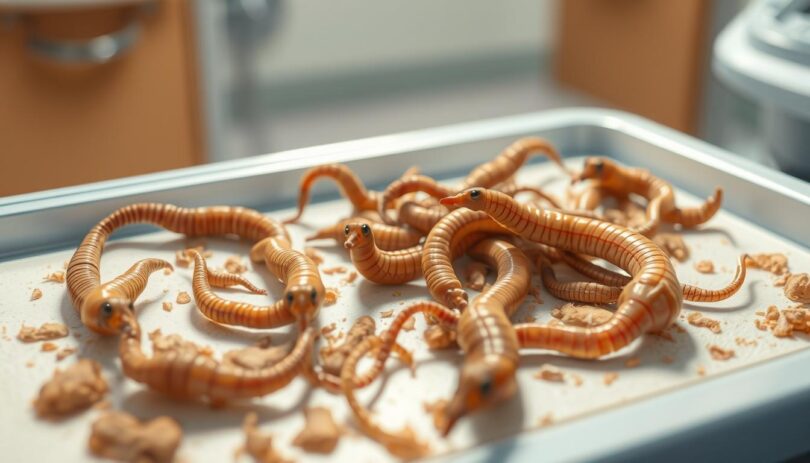Could your furry companion harbor dangerous parasites without showing a single symptom? This unsettling question keeps many pet owners awake at night, yet few realize how easily intestinal invaders compromise their dog’s health. While most assume outdoor adventures pose the greatest risk, even indoor pets face surprising exposure through everyday activities.
Veterinary professionals emphasize annual fecal exams because many parasites evade detection. Microscopic eggs and larvae often hide in seemingly normal stool, while adult worms like tapeworms might only appear as fleeting specks. Regular visual checks help, but they’re no substitute for laboratory analysis.
Four main parasites threaten U.S. pets: roundworms, hookworms, whipworms, and tapeworms. Each causes distinct health issues, from malnutrition to life-threatening complications. Early identification through stool samples prevents these silent attackers from damaging organs or spreading to human family members.
This guide equips owners with critical observation skills while explaining why professional testing remains irreplaceable. You’ll learn to spot subtle signs of infestation and understand how preventive care protects both pets and households.
Understanding Worms in Dog Poop Images
Unseen invaders in your pet’s gut could be stealing vital nutrients every day. These stealthy organisms thrive in canine digestive systems, silently impacting health through subtle but significant damage.
What Are Intestinal Parasites in Dogs?
Intestinal parasites are organisms living in a pet’s intestines, feeding on nutrients meant for their host. Common U.S. varieties include roundworms and tapeworms, which deprive animals of essential vitamins and minerals. Puppies face heightened risks due to weaker immune systems, making early detection critical.
Why Visual Inspection Matters
Regular stool checks help spot visible signs like tapeworm segments resembling moving rice grains. While some parasites appear as wriggling strands, most eggs and larvae require microscopic identification. This makes home observations a first alert system rather than definitive diagnosis.
Combining visual checks with veterinary fecal exams offers complete protection. Owners who notice unusual stool textures or foreign objects should consult professionals immediately. Proactive monitoring helps prevent severe complications before they escalate.
Identifying Common Parasites in Dogs
Recognizing intestinal invaders requires knowing their unique traits. While some parasites reveal themselves through visible clues, others demand laboratory analysis for confirmation. Let’s explore four frequent offenders and their telltale markers.
Visible Signs in Stool Samples
Roundworms often surface after deworming treatments, resembling pale spaghetti strands up to 7 inches long. Hookworms stay hidden due to their tiny size but might show as thread-like specks under close inspection. Tapeworm segments appear as mobile rice grains near a pet’s rear or in feces.
Whipworms prove most elusive, rarely appearing whole in stool. When visible, they resemble thread fragments with a swollen tip. These physical clues help owners decide when to collect samples for vet analysis.
Microscopic Differentiation
Lab exams reveal critical details invisible to the naked eye. Roundworm eggs display oval shapes with thick shells, while hookworm eggs show thin membranes. Whipworm eggs stand out with football-like contours and polar plugs at both ends.
Tapeworm eggs cluster in specialized packets rather than appearing individually. This explains why unexplained diarrhea sometimes signals infestation before visible evidence emerges. Veterinarians use these microscopic features to prescribe targeted treatments.
How Dogs Contract Worms
Parasites often invade through routine behaviors owners might overlook. Understanding transmission pathways helps create effective prevention strategies while explaining why infections persist despite good care.
Fecal-Oral Transmission and Environmental Risks
Microscopic eggs hitchhike on paws and muzzles during outdoor exploration. Pets sniffing contaminated soil or licking surfaces may ingest these invaders, starting new infections. Hookworm larvae bypass digestion entirely, burrowing through paw pads during walks.
Parks and yards become hotspots when infected animals leave eggs in feces. These resilient particles survive for months, creating invisible threats. Fleas compound risks by carrying tapeworm eggs, which pets swallow during grooming sessions.
Mother-to-Puppy and Ingesting Infected Prey
Newborns face dual exposure routes. Roundworms cross the placenta before birth, while hookworms travel through milk. This explains why 95% of puppies arrive with parasites, needing immediate deworming.
Hunting instincts introduce different dangers. Rodents and raw meat often contain tapeworm cysts. Consuming these hosts completes the parasite’s life cycle. Watch for digestive disturbances after scavenging, as they might signal new infections.
Even indoor pets remain vulnerable. Tracking dirt indoors or encountering fleas during vet visits demonstrates how no environment stays completely safe. Regular prevention remains crucial for all lifestyles.
Techniques for Detecting Worms in Dog Poop
Accurate parasite detection combines careful observation with advanced laboratory methods. While some clues appear visible, most infections require scientific tools to confirm. Veterinarians use a two-step approach to identify hidden threats in pets.
Using Visual Guides and Microscopic Exams
Collecting a fresh stool sample starts with proper technique. Use a clean bag to gather a teaspoon-sized portion within 24 hours of elimination. Refrigerate the sealed sample if immediate vet delivery isn’t possible.
At the clinic, technicians mix feces with a flotation solution. This liquid separates lightweight parasite eggs from heavier debris. Centrifugation then forces eggs upward, creating a concentrated layer for examination.
Under magnification, roundworm eggs show thick shells, while hookworm varieties appear oval with thin membranes. Tapeworm packets cluster uniquely, and whipworm eggs display distinct end plugs. These features help veterinarians prescribe targeted treatments.
Visible worm segments in stool should always accompany samples. Physical specimens allow faster identification than egg analysis alone. However, most infections remain invisible without professional tools, making annual exams vital for early intervention.
Preventing Worm Infestations in Your Dog
Protecting your pet from hidden threats requires consistent preventive measures. A combination of environmental management and targeted treatments creates multiple barriers against infestation.
Strategic Sanitation Practices
Remove feces from yards within 24 hours. Parasite eggs survive for months in soil, waiting for new hosts. High-traffic areas like dog parks need extra vigilance – wash paws after visits.
Disinfect food bowls weekly and sleeping areas monthly. Simple habits like handwashing after handling pets reduce cross-contamination risks. These steps disrupt transmission cycles effectively.
Breaking the Flea Life Cycle
Monthly topical treatments or oral medications stop fleas before they spread tapeworms. Treat all household pets simultaneously for full protection. Vacuum carpets regularly to eliminate eggs hiding in fibers.
Some heartworm preventatives also combat roundworms and hookworms. Ask your vet about combination products that address multiple threats. This approach simplifies protection while covering more risks.
Limit hunting behavior through leash walks and secure fencing. Rodents often carry parasites that infect curious pets. Watch for unusual stool changes after outdoor adventures, as they might indicate new exposures.
Annual fecal exams catch hidden infections early. Pair these checkups with tailored prevention plans based on your pet’s lifestyle and local parasite prevalence.
Treatment Options and Veterinary Guidance
Modern veterinary medicine offers precise solutions for eliminating intestinal parasites safely. The right approach depends on your pet’s age, health status, and the specific invader involved. Veterinarians tailor treatments using diagnostic insights to ensure complete eradication while minimizing side effects.
Prescription Dewormers vs. Over-the-Counter Remedies
Prescription medications target specific parasites identified through fecal exams. These formulas work faster and more effectively than general OTC options, which may miss certain infections. Puppies often need specialized dosing schedules to address their developing immune systems.
Over-the-counter products sometimes fail against resistant strains or mixed infections. Consulting a professional ensures your pet receives medications matching the exact type of parasite present. This prevents recurring issues and protects against drug resistance.
When to Schedule a Fecal Exam
Book a veterinary visit if your pet shows persistent symptoms like diarrhea or weight loss. Post-treatment exams confirm medication success, while annual checks catch hidden infections early. Puppies require testing every 2-3 months during their first year.
Adults benefit from yearly screenings, especially those with outdoor access or hunting habits. Prompt analysis after spotting unusual stool changes helps veterinarians intervene before complications arise. Combining expert guidance with preventive care keeps pets parasite-free long-term.
FAQ
Can puppies pass parasites to humans?
Yes. Some intestinal parasites like roundworms or hookworms pose zoonotic risks. Always wash hands after handling puppies or cleaning accidents, especially in homes with young children.
Are over-the-counter dewormers as effective as prescriptions?
Prescription medications target specific parasites identified through fecal tests. Over-the-counter options may miss certain strains or cause side effects. Consult your vet for tailored solutions.
How often should I check my dog’s stool for parasites?
Inspect your pet’s waste weekly for unusual textures, colors, or visible segments. Annual fecal exams by a veterinarian are recommended, even if no symptoms appear.










Leave a Comment